Professionally planned and installed plumbing in a private home will provide a comfortable level of living. Usually, the owners of the future household think about optimizing the laying of pipes only at the stage of completion of the repair or construction. In a private house, you need to act immediately, as soon as work with the foundation is completed.
The content of the article:
-
How is plumbing arranged in a private house
- Internal engineering systems of a private house
- Outdoor plumbing and sewerage system
-
House plumbing and sewerage project
- Sewer connection to plumbing
- Plumbing plan
-
Scheme of laying plumbing
- How plumbing is installed
- Installation of water pipes
- Installation of an external sewer system
How is plumbing arranged in a private house
Water supply and sanitation systems in private households can be built in several versions. It all depends on whether it is possible to connect plumbing to a centralized sewer, water line.
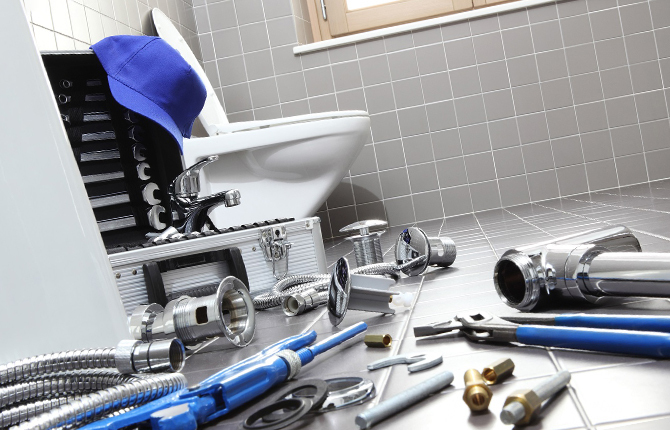
In a private house, this would be the best solution, since by paying bills for water supply and sewerage, the owner would be relieved of many problems with accommodation on the site.
well or well, septic tank, laying pipes, waste channels. And the cost of work to carry out plumbing would be much lower.If this is not possible, then the plumbing system in a private house will need to be made from four separate sections:
- internal water pipes;
- internal sewerage, taking into account the specifics of the placement of home plumbing - washbasins, bathrooms, kitchen sinks, showers, baths;
- external water supply line from the entrance to a private house to a well or caisson with a well;
- external outlet sewer pipe to a septic tank or sewage pit.
External plumbing lines are easier to design and install, but the problem of selecting and installing a septic tank is added to the list of tasks. It is better to forget about the classic cesspool if a private house is not on the outskirts of a small settlement.
The biggest problem will be with outdoor plumbing, as it is usually expensive to drill a water well privately. In addition, permission from the Water Inspectorate is required. If you rely on a well, then you need a specialist - a hydrogeologist, a team of workers, a submersible pump.
Internal engineering systems of a private house
You need to start planning plumbing in a private house with sewer pipes. This is important because there are requirements for laying sewerage indoors. In households, they must be adhered to so as not to have problems squeezing the contents back into the bathroom. In this case, you need to carry out plumbing in a private house once, and do it efficiently. Unlike water pipes, it will cost an order of magnitude more to redo the sewerage in an already built structure.
There are few requirements for plumbing and sewerage system of a private house. It makes a vertical prefabricated riser with one or two tees, with the help of which horizontal pipes are connected from the plumbing of the kitchen, bathroom, and bathroom.
In a private house, it is allowed to install a separate riser to drain the drains of a bathhouse equipped indoors. Moreover, the tie-in of the bath sewer must be done, adhering to the following rules:
- All pipes must be laid with drain slope. This means that the further plumbing such as a bathtub or toilet is installed from the tee, the higher the mortise drain pipe should be.
- Inside one floor of a private house, plumbing is usually connected to the sewer in series with one branch. An exception may be a two-way connection scheme, when two opposite branches with approximately the same amount of plumbing are connected to one riser tee.
- An inspection box with a hatch is installed at the bottom of the riser and at the exit from the house, through which you can perform maintenance and cleaning of sewer pipes.
Also, for private households, it is required to install a ventilation unit with a pipe on the riser, which ensures the safe removal of sewer gases outside the dwelling.
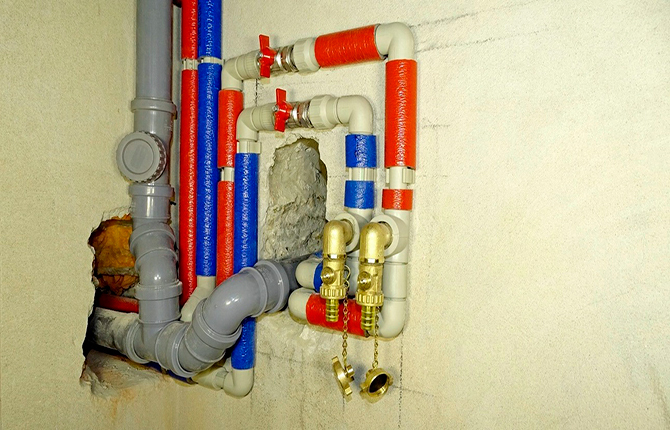
For private buildings and cottages used seasonally as a summer cottage, at the transition from internal to the external section of the sewer requires the installation of a drain valve to discharge residual liquid from the water shutter.
Water pipes inside the house are laid either in one branch or in several lines, depending on the number of plumbing connection points. For a bath and a heating boiler, you need to make a separate connection to the central water supply pipe.
Water supply is carried out through the basement of the wall or through the basement, if a filter, expansion tank, pumping station.
When drawing up a wiring diagram, it is necessary to balance the water flow through all outlets in order to exclude a pressure drop when simultaneous inclusion of several taps or one, but for plumbing with high water consumption (bath or kitchen washing).
If the house has several residential floors, each of which is privately used or owned, it is recommended that each owner put their own water riser. This will simplify the accounting of consumed water, repair, maintenance of plumbing.
Outdoor plumbing and sewerage system
It is somewhat more difficult to equip an external water supply site. Laying a pipe from the house to a water source is not the most difficult thing, although there may be problems if the water supply needs to be laid on the neighbors' private property. This happens, for example, if one water intake or well is used on the street or a small holiday village.
An ideal solution in a private house would be an ordinary well up to 12 m deep. At a greater depth, you will need to install a submersible pump and an intermediate water tank.
If the distance from the building to the water intake is less than 20 m, then water can be pumped by a pumping station installed in the basement of the house. Wells give a relatively small water debit, so in private households a buffer tank will be required in the basement or in the basement of the building.
On average, one well on the site gives up to 300 liters of water, which is enough to meet drinking needs, a standard set of plumbing.
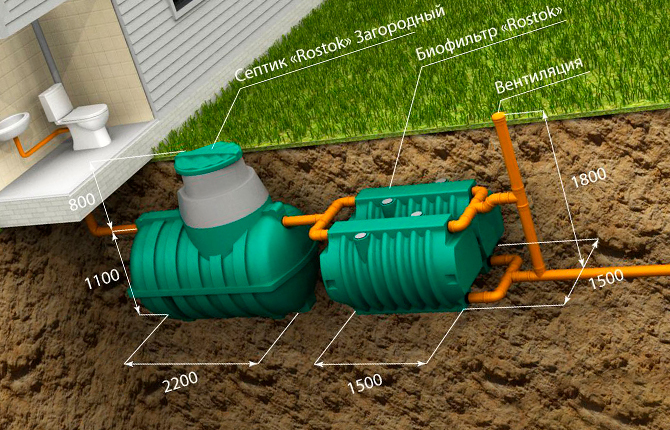
If a private cottage is used as a summer cottage, then a small vibration pump with a hose laid in a gutter is enough, even without laying a stationary water supply. To provide plumbing and a summer shower, a buffer capacity of 400 liters is enough.
For full-fledged private households with a personal plot, beds, a garden, it is best to make a well with a debit of at least 500 l / day. In this case, a caisson room is installed on its head for a submersible pump, a filter and an expansion tank.
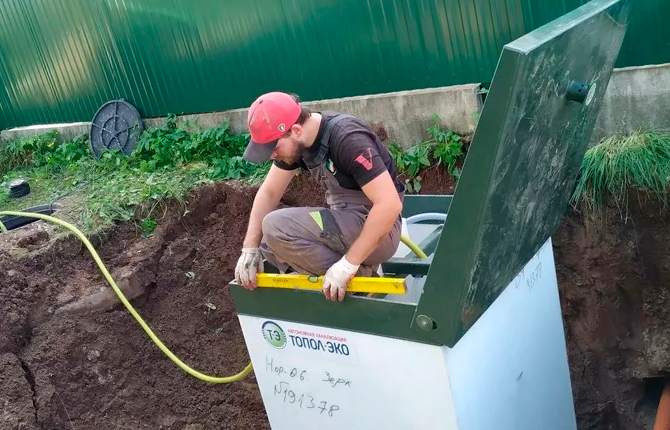
Planning an external sewer section in a private house begins with the choice of a place for the installation of a septic tank. It should be located no closer than 12 m from living quarters, a summer kitchen, water intakes or a well. The best option is to install a bioseptic. It can be placed at a distance of 5 m from the building. But septic tanks with biological sewage treatment have certain disadvantages:
- the volume of water from the sewerage of a private house should not exceed 400 l / day;
- to work, you will need to connect to the mains, electricity consumption from 400 W / h to 1.5 kW / h;
- periodically you will need to buy an active mass with microorganisms;
- high price, the simplest models - up to 50 thousand rubles. rub.
The advantage of a bioseptic is that purified water can be used in toilet plumbing, for watering plants, and even for washing cars.
Instead of a bioseptic, you can use the usual septic tank. It is enough to bury a barrel of 300-400 liters and make drainage under the aeration field. This is an underground area under the fertile layer, where the liquid part of the wastewater is disposed of. This is enough for a private house for 3-4 people and a regular plumbing kit.
For a summer residence, you can install a plastic barrel for 2.5-3 thousand rubles. l. with the possibility of pumping waste with a sewage machine.

House plumbing and sewerage project
Anyone who decides to create a water supply and drainage system on their own will have to face one problem. In the construction of a private house, equipment is used only for arranging the foundation, the rest of the work is done manually. Therefore, the accuracy is appropriate.
Everyone who is going to do plumbing in a private house with their own hands needs to be prepared for constant adjusting the project, making changes according to the measured "live" dimensions of the basement part of the walls and internal premises. The laying scheme should be done without fail, but you will have to act in many respects by the method of fitting in place.

Sewer connection to plumbing
The plan for laying sewer pipes is easiest to make according to the sketches of the layout of the premises. Each private household has its own specific location of rooms. Therefore, it will be necessary to remove the tracing paper from the plan of the house and first apply the plumbing installation points in the bathroom and the bathroom, taking into account the possibility of laying sewer pipes.
In the simplest case, the sewerage in a private household consists of one pipe, into which the following plumbing is embedded as it moves away from the sewer riser:
- toilet;
- bidet;
- wash basin;
- bath or shower;
- kitchen sink.
When choosing places for a washbasin, toilet and bath, individual preferences and anatomy should be taken into account. residents, but the above plan for the location of plumbing in private housing is considered optimal and most common.
If you have to put a bathtub and a cabin before laying sewers in a private house (this also happens), then you need to additionally measure the floor levels in the bathroom and bathroom.
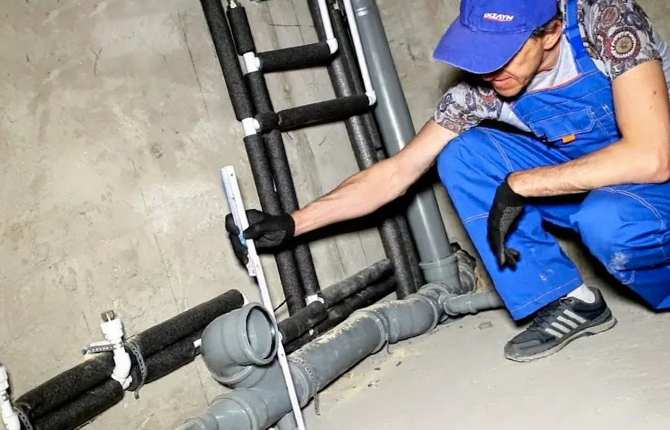
Visually, it seems that the floor in the toilet and bathroom is on the same level. Actually this is not true. It will be necessary to draw up a diagram and recalculate the height of the sewer pipe for the bath and toilet, so that it does not happen that after installing the plumbing, the drain will be below the level of sewage.
Plumbing plan
Laying water pipes is easier than sewerage. Most of the plumbing in a private house is connected to the "water" using a flexible connection, so the location of the conclusions is not as critical as in the case of sewer drains.
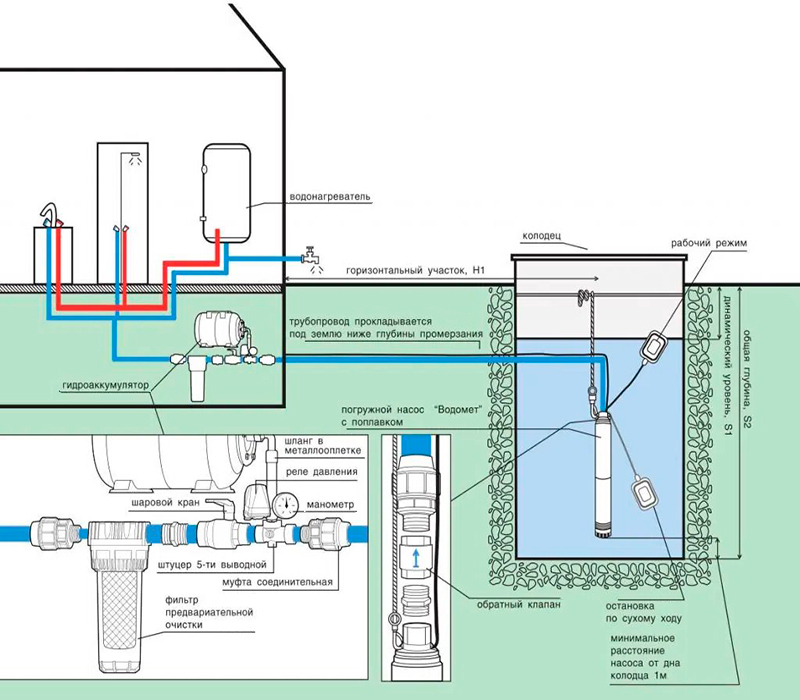
An exception may be the connection of the bath. In this case, the section of water supply from the water meter to the bath faucet is recommended to be made with a pipe with a cross section of at least ¾ inch.
Scheme of laying plumbing
In any private house, the installation of sewer pipes is usually combined with the installation of a toilet bowl and other plumbing fixtures. The initial and final elements are placed on a separate branch, the rest crashes into the pipe as plumbing items are installed.
The site for entering the sewer into the house should already be assembled, covered with thermal insulation and equipped with a revision. Usually all this is transferred to the basement, basement or, in extreme cases, to the caisson under the floor. Next, a riser with a diameter of 100 mm is brought up, on which a Y-tee and a plug are put on. The height of the structure should be at least 130-150 cm above the level of the outlet to the external section of the sewer.
How plumbing is installed
The installation of a toilet, bathtub, washbasin and sink can be done in several ways. Usually the installation of plumbing begins with the toilet.
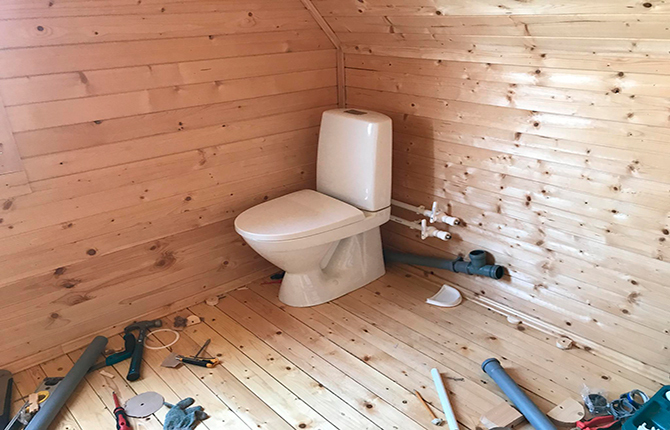
If it is connected directly to the sewer riser, then you only need to adjust the position in this way plumbing fixtures in height so that between the toilet drain pipe and the tee can be inserted corrugated adapter. Immediately mark the mount on the floor and punch holes for the plugs. In a private house, the toilet should be located at the lowest point of the sewer pipe. The rest of the plumbing is located above the level.
In a private house, the area between the common sewer riser and the bathroom is best done with a weaving pipe. After the bath, you can make any branching with channels with a diameter of 50 mm, connect anything you like - there will be no clogging of the sewer.
We connect the rest of the plumbing in the following order:
- We lay out the tees along the line of the future sewerage. For a washbasin and a sink T-shaped, for a bathtub Y-shaped.
- We temporarily connect the tees to the outlets of the bellows for the bath, washbasin, shower and sink.
- We cut sections of the required length from the pipe blank, with the help of which we connect the tees into one sewer pipe. So that the structure does not sag under its own weight, we put supports made of wooden bars under it.
It remains only to align the pipe, check for a slope in each section, lubricate the rubber bands sanitary sealant, assemble and fix the sewer with clamps to the wall.
Installation of water pipes
The technology for assembling a water supply system inside a private house is no different from a similar procedure for apartments or any other housing. Water pipes are usually embedded inside the walls, under plaster or cladding with slabs. Can be laid in a gutter or dressed in thermal insulation made of polypropylene foam.

First of all, you need to collect the input to the room. Usually, the inspection requires installing a water meter in a caisson near the house, but in this case, you will have to heat the pipes and the device with an electric cable. For private households, the installation of the device in the basement is considered optimal. Here you can also put a filter, valves, a pumping station and a storage tank.
Part of the water supply from the well to the entrance to the house is laid in the ground below the freezing depth. Steel pipes are treated with mastic and covered with polystyrene chips. Plastic can simply be wrapped with a polypropylene foam cover. Sand and clay are poured from above.
Installation of an external sewer system
The outlet from the riser to the outer pipe must be insulated. The revision box is also placed here. Sewerage of a private house should be easy to maintain and clean. Therefore, the section of the pipe from the riser under the foundation blind area to the settling tank must be made straight, with a diameter of at least 100 mm. Slope increase to 10about.
A settling tank is placed next to private housing construction, with a capacity of up to 50-100 liters, depending on the number of connected plumbing. Buried in the ground at a distance of 3-5 m from the foundation. The walls are insulated with external thermal insulation. The cover must be plastic, durable, with a sewer gas discharge valve.
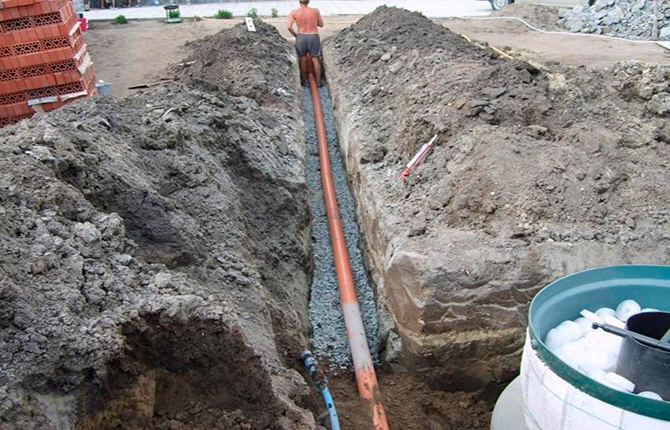
An outlet pipe is connected to the outlet of the sump. It, as a rule, is located 40-50 cm below the entrance. The outer part of the sewer from the tank to the septic tank is laid in a trench on a sand and gravel cushion. Covered with sand and covered with geotextile.
If private housing is used throughout the year, then no additional protection is required. For the sewerage of a summer cottage, some experts advise to embed a flush fitting, put it at the outlet of the riser in the basement. Before the end of the season, the pipe is washed through the fitting with hot water to remove sediment. But, as practice shows, a new sewage system in a private house has been working normally for 10-15 years and without flushing.
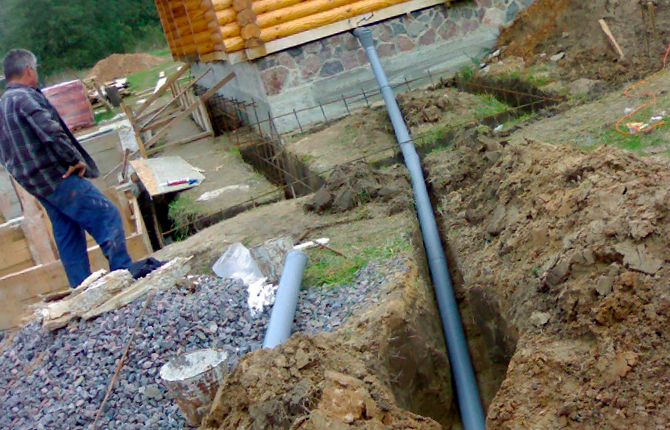
The scheme for installing plumbing in a private house largely depends on the type of building, the layout of the rooms, the construction of the basement of the walls and the presence of a basement. Therefore, the standard technology for assembling sewerage and plumbing, plumbing installations have to be adapted locally in each case.
Tell us about your experience in arranging and installing plumbing in a residential building in the comments. Save the material in bookmarks so as not to lose useful information.


